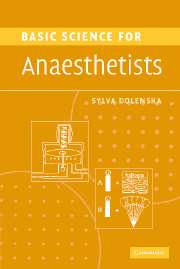Book contents
- Frontmatter
- Contents
- List of abbreviations and symbols
- List of figure captions
- Forewords
- Preface
- Preface to the second edition
- Part 1 Physics, mathematics, statistics, anaesthetic apparatus
- Part 2 Clinical measurement
- Part 3a Physiology: the cardiovascular system
- 1 The cardiac cycle and the intravascular pressure waveforms
- 2 Cardiovascular effects of intermittent positive pressure ventilation
- 3 Control of cardiac output, regulation of cardiac function
- 4 Cardiac cycle: pressure-volume relationships
- 5 Blood pressure and blood volume relationship
- 6 Cerebral blood flow
- 7 Coronary circulation
- Part 3b Physiology: the respiratory system
- Part 4 Pharmacology
- Further Reading
- Index
2 - Cardiovascular effects of intermittent positive pressure ventilation
from Part 3a - Physiology: the cardiovascular system
Published online by Cambridge University Press: 13 August 2009
- Frontmatter
- Contents
- List of abbreviations and symbols
- List of figure captions
- Forewords
- Preface
- Preface to the second edition
- Part 1 Physics, mathematics, statistics, anaesthetic apparatus
- Part 2 Clinical measurement
- Part 3a Physiology: the cardiovascular system
- 1 The cardiac cycle and the intravascular pressure waveforms
- 2 Cardiovascular effects of intermittent positive pressure ventilation
- 3 Control of cardiac output, regulation of cardiac function
- 4 Cardiac cycle: pressure-volume relationships
- 5 Blood pressure and blood volume relationship
- 6 Cerebral blood flow
- 7 Coronary circulation
- Part 3b Physiology: the respiratory system
- Part 4 Pharmacology
- Further Reading
- Index
Summary
Intermittent positive pressure ventilation causes changes in intrathoracic pressure and blood volume, which are reflected in the cardiovascular parameters. Four phases can be recognized (see Figure 89):
Phase I: blood is forced into the left atrium by the increased intrathoracic pressure – blood pressure rises and reflex bradycardia follows.
Phase IIa: blood pressure falls because of decreased venous return – the result of the raised intrathoracic pressure.
Phase IIb: blood pressure is restored to normal by reflex tachycardia.
Phase III: venous return is decreased on lowering the intrathoracic pressure as there is now increased venous capacity in the lungs. Blood pressure falls initially but normalizes soon as reflex tachycardia persists.
Phase IV: persisting tachycardia results in an overshoot of blood pressure; heart rate then drops back to normal (baroreceptor reflex) and blood pressure then also normalizes.
The magnitude of the effect on blood pressure as a result of effects on right and left ventricular filling depends on blood volume and the integrity of the sympathetic nervous system control, i.e. effects will be exaggerated in the presence of hypovolaemia, sympathetic blockade (this includes general anaesthesia) or autonomic dysfunction (e.g. diabetic neuropathy), or a combination of factors (ill patients, e.g. sepsis), as compensation is lost (‘blocked Valsalva’). The ventilator settings also play a role – fast ventilation rates with a long inspiratory phase will allow little time for compensation; high ventilation pressures will cause greater effects.
- Type
- Chapter
- Information
- Basic Science for Anaesthetists , pp. 114 - 115Publisher: Cambridge University PressPrint publication year: 2006



